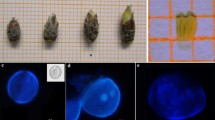Abstract
Wheat microspores mechanically isolated from the anthers before culture and isolated from the anthers during the hole culture period in a chemically defined medium resulted in proembryos, embryos and finally plants. Of the four genotypes included, all responded with proembryos, and the two spring wheats ‘Ciano’ and ‘Walter’ gave rise to macroscopic embryos and plants. The frequency of embryo regeneration and the frequency of albino plants in both ‘Ciano’ and ‘Walter’ was in accordance with previously obtained results with anther culture derived material.
Similar content being viewed by others
Abbreviations
- 2,4-d :
-
2,4-dichlorophenoxy acetic acid
- NAA:
-
1-naphthaleneacetic acid
References
Baillie AMR, Epp DJ, Hutcheson D & Keller WA (1992) In vitro culture of isolated microspores and regeneration of plants in Brassica campestris. Plant Cell Rep. 11: 234–237
Burnett L, Yarrow S & Huang B (1992) Embryogenesis and plant regeneration from isolated microspores of Brassica rapa L. ssp. Oleifera. Plant Cell Rep. 11: 215–218
Cho MS & Zapata FJ (1988) Callus formation and plant regeneration in isolated pollen culture of rice (Oryza sativa L. cv Taipei 309). Plant Science 58: 239–244
Cho Ms & Zapata FJ (1990) Plant regeneration from isolated microspore of indica rice. Plant Cell Physiol. 31: 881–885
Chuong PV & Beversdorf WD (1985) High frequency embryogenesis through isolated microspore culture in Brassica napus L. and B. carinata Braun. Plant Science 39: 219–226
Coumans MP, Sohota S & Swansom EB (1989) Plant development from isolated microspores of Zea mays L. Plant Cell Rep. 7: 618–621
Datta SK & Wenzel G (1987) Isolated microspore derived plant formation via embryogenesis in Triticum aestivum L. Plant Science 48: 49–54
Dunwell JM (1986) Pollen, ovule and embryo culture as tools in plant breeding. In: Withers LA & Alderson PG (Eds) Plant Tissue Culture and its Agricultural Applications (pp 375–404). Butterworths, London
Henry Y & de Buyser J (1981) Float culture of wheat anthers. Theor. Appl. Genet. 60: 77–79
Imamura J, Okabe E, Kyo M & Harada H (1982) Embryogenesis and plantlet formation through direct culture of isolated pollen of Nicotiana tabacum cv. Samsum and Nicotiana rustica cv. Rustica. Plant Cell Physiol. 23(4): 713–716
Kasha KJ, Ziauddin A & Simion E (1990) Barley and wheat microspore culture. Abstracts VIIth International Congress on plant tissue and cell culture (p. 183) Amsterdam
Lichter R (1982) Induction of haploid plants from isolated pollen of Brassica napus. Z. Pflanzenphysiol. 105: 427–434
Olsen FL (1991) Isolation and cultivation of embryogenic microspores from barley (Hordeum vulgare L.). Hereditas 115: 255–266
Ouyang JW, Zhou SM & Jia SE (1983) The response of anther culture to culture temperature in Triticum aestivum L. Theor. Appl. Genet. 66: 101–109
Ouyang TW, Hu H, Chuang CC & Tseng CC (1973) Induction of pollen plants from anthers of Triticum aestivum L. cultured in vitro. Scientica Sinica 16: 79–95
Pescitelli SM, Mitchell JC, Jones AM, Pareddy DR & Petolino JF (1989) High frequency androgenesis from isolated microspores of maize. Plant Cell Rep. 7: 673–676
Reinert J, Bajaj YPS & Heberle E (1975) Induction of hapioid tobacco plants from isolated pollen. Protoplasma 84: 191–196
Tuvesson IKD, Pedersen S & Andersen SB (1989) Nuclear genes affected albinism in wheat (Triticum aestivum L.) anther culture. Theor. Appl. Genet. 78: 879–883
Wang X & Hu Han (1984) The effect of potato II medium for triticale anther culture. Plant Sci. Lett. 36: 237–239
Wei ZM (1982) Pollen callus culture in Triticum aestivum L. Theor. Appl. Genet. 63: 71–73
Wei ZM, Kyo M & Harada H (1986) Callus formation and plant regeneration through direct culture of isolated pollen of Hordeum vulgare cv. ‘Sabarlis’. Theor. Appl. Genet. 72: 252–255
Ziauddin A, Marsolais A, Simion E & Kasha KJ (1992) Improved plant regeneration from wheat anther and barley microspore culture using phenylacetic acid (PAA). Plant Cell Rep. 11: 489–498
Author information
Authors and Affiliations
Rights and permissions
About this article
Cite this article
Due Tuvesson, I.K., Viktoria Öhlund, R.C. Plant regeneration through culture of isolated microspores of Triticum aestivum L.. Plant Cell Tiss Organ Cult 34, 163–167 (1993). https://doi.org/10.1007/BF00036097
Received:
Accepted:
Issue Date:
DOI: https://doi.org/10.1007/BF00036097




